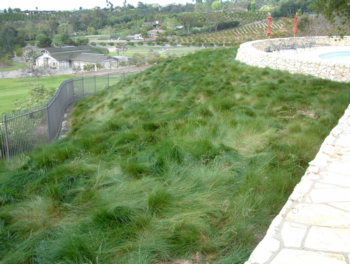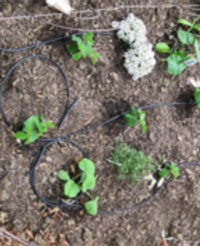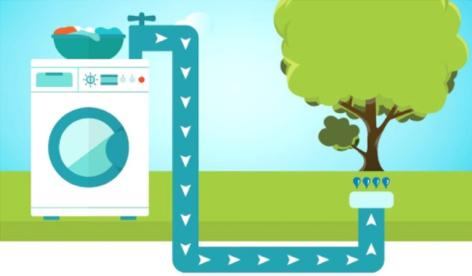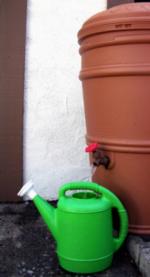Using water effectively in the garden
-
Marin’s climate is Mediterranean in nature, meaning it’s prone to periodic drought. Most years, we get 90% of our rain between November and March, and we have seven to nine months with little to no rain. Despite our dry season, this climate allows us to grow a wonderful array of plants. Along with all of our wonderful blended cultures, many of us and our ancestors also brought with us a desire for plants that prefer much wetter summers than naturally occurs. That’s why irrigation systems were developed, to fill in where rainfall is scant or missing altogether. Here are some tips for reducing water use in your garden.
Reconsider the lawn There are numerous alternatives to conventional turf grass, such as this hillside planted with red fescue. Photo: GardenSoft
There are numerous alternatives to conventional turf grass, such as this hillside planted with red fescue. Photo: GardenSoft
When it comes to water use, the top inappropriate plant choice is a lawn, which requires immense amounts of summer water. In general, unless you've got kids or pets actively playing on a lawn, it would be prudent to consider something less wasteful. Even a pond can use less water than the same-sized lawn over the growing season. Synthetic lawns are a viable option if a place to play is still the main function of the space. The choices today are not at all like the old AstroTurf.If you must keep your lawn, consider reducing its size and be sure to irrigate it with efficient multistream, multitrajectory rotors that maintain the highest uniformity over the lawn area, or consider sub-surface drip irrigation. If you still have the old impact heads in your system, it's time to upgrade. Eliminate all runoff by cycling your run times, let the lawn grow to a taller height, and don't over fertilize.
There are many wonderful alternatives to a lawn. A meadow appearance can be created using one of the many "no-mow" grass blends, some of which are completely native and available as sod. Carex and other sedges are another option. Many people are opting to replace their lawn area with a habitat garden for local wildlife or even productive vegetable gardens, both of which take less water than the traditional lawn.
Understand how drip systems work and what the goal is Drip systems range from simple to elaborate. Photo: UC Regents
Drip systems range from simple to elaborate. Photo: UC Regents
Irrigation systems range from simple to elaborate. A modern Evapotransporation (ET) or weather-based controller can help save lots of water, usually at least 35% over the season. This sounds complicated, but it’s built right into the system and the savings are automatic. To maximize efficiency, your system should be organized so that each valve is a hydrozone that has the same water needs. Of course, no system will save water if there are leaks. A regular checkup is essential to any system. It pays to understand the basic components of an irrigation system as well as how to design and maintain it. Refer to the following pages for more detailed information:• The basics of an irrigation system
• How to design, hydrozone, and build a system that meets your needs
• Installing and maintaining your drip system
• Tips for reducing water use in times of droughtGreywater diverts water that would otherwise go down the drain
Graywater can be legally diverted from showers, sinks, and washing machines into the garden for lush summer growth - all from water that would have gone down the sewer. You can learn more about this water-saving strategy here. One type of greywater system recycles water from your washer for landscape use. (Courtesy Pasadena Water and Power)
One type of greywater system recycles water from your washer for landscape use. (Courtesy Pasadena Water and Power) Rain barrels allow gardeners to capture water and use it during dry months. Photo: UC Regents
Rain barrels allow gardeners to capture water and use it during dry months. Photo: UC Regents
Be water smart: harvest rain, use permeable surfaces, and mulch
Rain harvesting, captured from our downspouts and stored for summer garden use or diverted from the gutter into bioswales, can help to slow, spread and sink water into our aquifers and reduce the amount of water that flows to our storm drains. Permeable pavers will reduce runoff from hardscape areas.
Regular mulching in the garden goes a long way toward saving water as well. Mulch can increase the infiltration rate of the soil, increase the water holding capacity, and reduce the erosion of our precious topsoil.
Original article by Dave Phelps for the Marin IJ
Edited by Marie Narlock for the Leaflet




